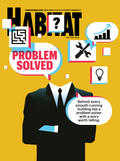HABITAT
Condo Board Learns the High Cost of Deferred Maintenance
Carol Ott in Building Operations on April 22, 2025

After ignoring numerous engineers' reports, a condo board had its day of reckoning.
Over the years, the various condo boards at a small converted loft building commissioned several facade engineering studies. All of them discovered noticeable cracking and recommended remediation. Each board apparently believed that a long-standing brick building was safe — and they apparently were unwilling to pay for repairs that were not absolutely necessary — and so they never moved forward with the suggested fixes.
Big mistake.
After hiring a new management company, the board brought in another team of engineers to take a fresh look at the facade. During the walk-through, the structural engineer saw that the building’s bearing walls were leaning, and immediately notified the Department of Buildings. A few days later, residents of the condominium were given the worst possible news.
They had five days to evacuate the unsafe building.
Compounding the enormous logistical challenges the condo faced was a cash problem. “The question was how to raise the capital to remediate a project projected to cost between $2 [million] and $3 million,” says Carl Cesarano of Cesarano & Khan, the condo’s accountant. The remediation cost was a moving target, he adds, and the big spread made raising capital all the more challenging.
If this were a co-op, he says, the building could be leveraged as collateral and it could get a line of credit. In the condominium structure, however, unit-owners own their units, so leveraging the building isn’t possible. The kind of loan a condominium can get is called a common interest realty association, or CIRA, loan. There are only a few lenders who will make such loans, and the condo’s unsafe condition made the search that much more difficult.
“We went to different lenders, and when they heard that this was a potential building collapse, just about all of them said it didn’t meet their underwriting criteria,” Cesarano says. “One lender said to me, ‘We wouldn’t touch this with a 10-foot pole.’” Finally, though, a lender was found, but the loan came with conditions attached. “The lender said it was willing to give us a loan with all the shortcomings of the property,” Cesarano says, “but the owners must also have a chip in the game.” That chip was an immediate assessment of $1.6 million.
The high cost of doing things on the cheap was beginning to come into focus.
The assessment was only one part of the lender's requirement; the second was the creation of a long-term assessment to fund the loan. Cesarano says the lender wanted the condo to create a line item in its budget specifically dedicated to paying back the loan.
This immediate assessment to unit-owners averaged around $65,000, depending on their ownership percentage. The lender’s $2 million loan, which was a revolving line of credit, was spread out over a six-year payback period, which meant that each unit-owner was assessed, on average, another $77,000 over the six years. Meanwhile, of course, the unit-owners had to continue to pay their common charges while the condo was undergoing repairs.
Because the cost of the project wouldn’t be certain until the remediation began, Cesarano took on a new role. “The condo board wanted somebody to watch the contractors and almost act as an owner’s rep for financial affairs,” he says. “Not only to track the financial outlay of the project but to augment how the ongoing assessments needed to be structured.” The loan was a revolving line of credit, so the condo didn’t have to draw it at once, only as needed. That made tracking the financials all the more important.
There's a lesson here for all co-op and condo boards.
“From my perspective,” Cesarano says, “boards should embrace their engineers and have an accountant by their side. A lot of boards feel engineers come in and overstate what’s needed.” As a result, he adds, boards frequently fail to include the engineer's findings in a building’s financial statement. “If they did, it would show that the building is underfunded.”
Failing to admit that reality, Cesarano adds, “is a double-edged sword.”
It's a lesson this condo board learned the hard way.



